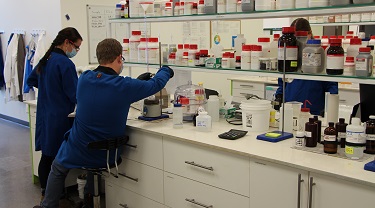While not all downturns are created the same, what made the COVID-19 economic crisis truly unprecedented—apart from its scale and scope—was that it was largely the result of a globally co-ordinated, self-inflicted shutdown of the entire in-person, non-essential economy. What started as a massive supply-side shock, quickly transformed into a complete collapse in demand, owing to a surge in unemployment and off-the-chart levels of uncertainty. Public support measures, including fiscal and liquidity support, quickly kicked in, amounting to some 20% of global gross domestic product (GDP) in advanced economies alone.
Facilitated by the sudden increase in personal savings and the rapid adoption of advanced communication technologies, remote working and online shopping helped the global consumer adapt. The money normally spent on leisure and hospitality services was either redirected into savings or went into purchasing more goods online. Changing what we consume and how we consume allowed the economic data to decouple from the epidemiological data, even in the face of sporadic variant flareups. If anything, global supplies were struggling to keep up.
As vaccine deployment widened, and we lurched ever-closer to that elusive state of herd-immunity, we entered 2022 with impressive momentum. In fact, it was clear that our key challenge would be whether the global economy would have the capacity to keep pace. As co-ordinated, uniform and stable as the shutdown was, so too would be the reopening, or so the logic went. Fortified by two years of pent-up demand, and in some cases more, this would facilitate a growth surge, testing the limits of the world’s supplies and global transport network.
Then, on Feb. 24, the Russian forces of President Vladimir Putin launched a widescale invasion of neighbouring Ukraine, with military assaults on key cities, including its capital, Kyiv. The war, and resulting wide-ranging sanctions and trade restrictions by both Russia and the West, dramatically increased uncertainties surrounding the outlook, bringing high levels of volatility across multiple series in our forecast.
At the time of writing, reports of progress toward a ceasefire in Ukraine served to calm markets. In our spring Global Economic Outlook, EDC Economics believes that commodity prices are in for a period of heightened volatility, with near-term prices ever disconnected from supply-demand fundamentals, and more driven by headline risk as well as the disruptive levels of liquidity sloshing around the system. Oil and natural gas prices are a central focus, with Russia accounting for 10% of the world’s oil production. However, the conflict also threatens large amounts of the world’s agricultural and metals supplies, in addition to significant supplies of coal and wood.
You should also check out
With growing risks, Canadian companies face new challenges. EDC’s Global Economic Outlook offers insights to help you make better business decisions.
EDC Economics expects WTI crude to average US$113/bbl this year, before falling back to US$92/bbl in 2023. Gas prices will follow a similar pattern, largely in response to extreme volatility around the war in Ukraine. Copper prices will continue to be driven by strong demand, thanks to the global energy transition, and near-term supply constraints; with prices averaging US$9,393 this year, before falling back to US$8,649 in 2023. Heightened uncertainty will keep gold prices up at US$1,804/troy ounce in 2022, easing back to US$1,610/troy ounce next year.
These additional upstream pricing pressures only serve to further exacerbate near-term global inflationary trends. In response, the Bank of Canada, the Bank of England and the U.S. Federal Reserve have reined in their quantitative-easing (QE) programs and started raising interest rates, for the first time since 2018.
The European Central Bank (ECB) will likely continue to weigh the potential inflationary impacts resulting from high energy prices against the impacts of any resulting hit to confidence, consumption, production, and growth from the war. We expect the ECB to focus on a downscaling of its asset purchases, before raising rates in 2023. Any interruption in gas supplies to Europe is an additional downside risk to economic growth. We expect this policy split to play out on currencies as well.
The U.S. economy is forecast to grow by 4% this year and a still-strong 3.1% in 2023. Our base case calls for Euro Area growth of 2.9% in 2022 and 2.5% in 2023, with significant risks to that outlook. The Canadian economy will see continued strength in 2022, up 4.1%, moderating to 2.6% in 2023. All told, we anticipate developed markets to post growth of 3.3% in 2022, before stabilizing at 2.8%, in 2023.
Similarly, on the developing markets front, EDC Economics expects a split in growth prospects. The weakened property and construction sectors in China, together with lower government spending and a continued adherence to its zero-COVID-19 policy, pose downside risks to the Chinese economy this year. Chinese growth will hover around 5% over our forecast horizon, a reality that has been publicly acknowledged by the Chinese authorities. Aside from potential longer-term implications for the global economy, these historically low levels of growth in China will have a moderating impact on global commodities demand.
Developing markets that export critical commodities will continue to benefit from higher-than-average prices, and from the ongoing impacts of the post-pandemic surge in global demand, including a rebound in global tourism. However, the volatility in agricultural supplies and prices, due to the situation in Eastern Europe, and the impact of reduced planting on future yields, are a concern for major food importers. For certain markets in the Middle East and North Africa this will increase risks around political stability. EDC Economics expects developing economies to grow by a combined 4.5% in 2022, and 4.6% in 2023.
The bottom line?
As the economic impacts of COVID-19 recede, the global economy was heating up. The war in Ukraine, however, has complicated the outlook significantly, triggering a break between the fortunes of the world’s major economic blocs. The events of the day are a volatility overlay, which we’ll monitor closely, exacerbating some trends and washing others out.
However, a tight job market and strong consumer savings will help drive growth in North America. While inflationary pressures far outweigh any fears of a growth slowdown here, we expect central banks to effectively manage any overheating, helped by a rotation in demand back toward services and additional spending on business investment.
As we move past the fog of war, this underlying momentum should provide a solid foundation for the global economy to put the COVID-induced economic crisis behind us. We expect the global economy to grow by 4.1% in 2022 and 3.9% in 2023.
As always, at EDC Economics, we value your feedback. If you have ideas for topics that you would like us to explore, please send them our way and we’ll do our best to cover them.
This commentary is presented for informational purposes only. It’s not intended to be a comprehensive or detailed statement on any subject and no representations or warranties, express or implied, are made as to its accuracy, timeliness or completeness. Nothing in this commentary is intended to provide financial, legal, accounting or tax advice nor should it be relied upon. EDC nor the author is liable whatsoever for any loss or damage caused by, or resulting from, any use of or any inaccuracies, errors or omissions in the information provided.






